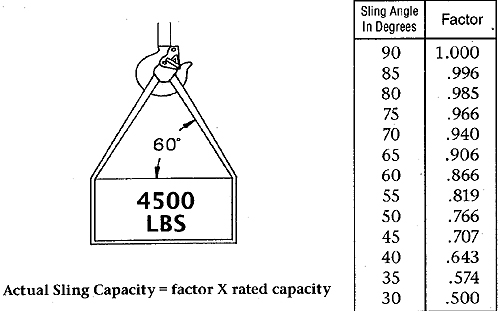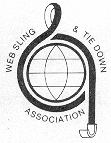Inspection, Care and Use
of Synthetic Web Slings
Removal From Service
A sling shall be removed from service if any of the following are visible:
1. If sling rated capacity tag is missing or not readable.
2. Acid or alkalis burns.
3. Melting, charring or weld spatter of any part of the sling.
4. Holes, tears, cuts, snags or embedded particles.
5. Broken or worn stitching in load bearing splices.
6. Excessive abrasive wear.
7. Knots in any part of the sling.
8. Distortion, excessive pitting, corrosion or broken fittings.
9. Any conditions which cause doubt as to the strength of the sling.
Operating Practices
1. Determine weight of the load. The weight of
the load shall be within the rated capacity of the sling.
2. Select sling having suitable characteristics for the
type of load, hitch and environment.
3. Slings shall not be loaded in excess of the rated capacity.
Consideration shall be given to
the sling to load angle which affects rated capacity. (see load chart)
4. Slings with fittings which are used as a choker hitch
shall be of sufficient length to assure that the choking action is on the
webbing and never on a fitting.
5. Slings used in a basket hitch shall have the load balanced
to prevent slippage.
6. The opening in fittings shall be the proper shape and
size to insure that the fitting will seat properly in the hook or other
attachments.
7. Slings shall always be protected from being cut by sharp
corners, sharp edges, protrusions or abrasive surfaces.
8. Slings shall not be dragged on the floor or over an
abrasive surface.
9. Slings shall not be twisted or tied into knots, or joined
by knotting.
10. Slings shall not be pulled from under loads if the load is resting
on the sling.
11. Do not drop slings equipped with metal fittings.
12. Slings that appear to be damaged shall not be used unless inspected
and accepted.
13. The sling shall be hitched in a manner providing control of the
load.
14. Personnel, including portions of the human body, shall be kept
from between the sling and the load, and from between the sling and the
crane hook or hoist hook.
15. Personnel shall stand clear of the suspended load.
16. Personnel shall not ride the sling.
17. Shock loading shall be avoided.
18. Twisting and kinking the legs (branches) shall be avoided.
19. Load applied to the hook shall be centered in the base (bowl) of
hook to prevent point loading on the hook.
20. During lifting, with or without the load, personnel shall be alert
for possible snagging.
21. The web slings' legs (branches)shall contain or support the load
from the sides above the center of gravity when using a basket hitch.
22. Slings shall be long enough so that the rated capacity of the sling
is adequate when the angle of the legs (branches) is taken into consideration.
(see load chart)
23. Place blocks under load prior to setting down the load, to allow
removal of the web sling, if applicable.
24. Nylon and Polyester slings shall not be used at temperatures above
of 194 degrees F (90 degrees C).
25. Exposure to sunlight or ultra-violet light degrades the strength
of slings. Store slings in a cool, dry and dark place when not in use.
Inspection
A. Initial Inspection
Before any new or repaired sling is placed in service, it shall be
inspected by a designated person to ensure that the correct sling is being
used, as well as to determine that the sling meets the requirements of
this specification and has not been damaged in shipment.
B. Frequent Inspection
This inspection shall be made by a qualified person handling the sling
each time the sling is used.
C. Periodic Inspection
This inspection shall be conducted by designated personnel. Frequency
of inspection should be based on:
1. Frequency of sling use
2. Severity of service conditions
3. Experience gained on the service life of slings used in similar
applications
4. Periodic inspections should be conducted at least monthly

Sling Angle and Sling Load Chart
SLING ANGLE is the angle measured between a horizontal line and the
sling leg or body. This angle is very important and can have a dramatic
effect on the rated capacity of the sling. As illustrated, when this angle
decreases, the load on each leg increases. This principle applies whether
one sling is used to pull at an angle, in a basket hitch or for multi-legged
bridle slings. This data is only for equally loaded sling legs. Sling angles
of less than 30 degrees are not recommended.
 |

Additional requirements and safe operating practices are outlined in
current OSHA and ANSI/ASME B30.9 and/or other regulations as applicable. |
|



